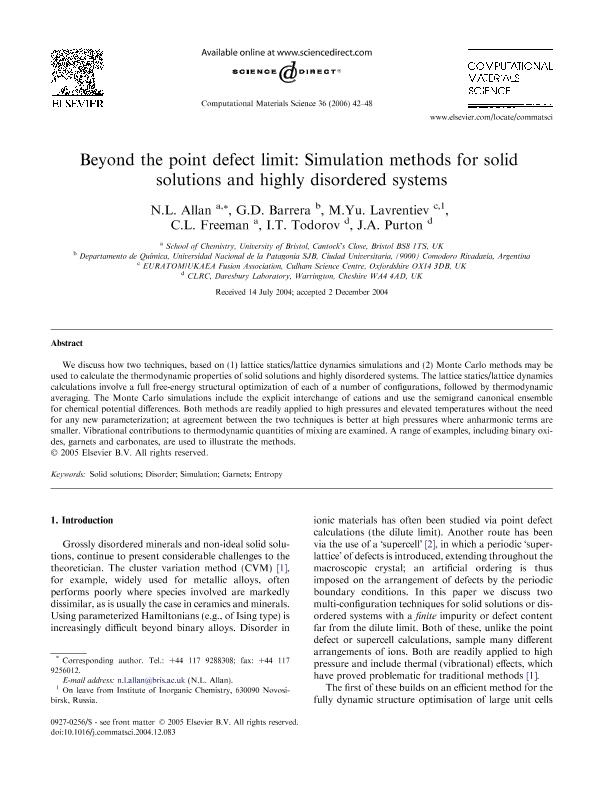Mostrar el registro sencillo del ítem
dc.contributor.author
Allan, N. L.

dc.contributor.author
Barrera, Gustavo Daniel

dc.contributor.author
Lavrentiev, M. Yu

dc.contributor.author
Freeman, C. L

dc.contributor.author
Todorov, I. T.

dc.contributor.author
Purton, J. A.

dc.date.available
2017-05-19T15:54:29Z
dc.date.issued
2006
dc.identifier.citation
Allan, N. L.; Barrera, Gustavo Daniel; Lavrentiev, M. Yu; Freeman, C. L; Todorov, I. T.; et al.; Beyond the point defect limit: simulation methods for solid solutions and highly disordered systems; Elsevier; Computational Materials Science; 36; 1-2; -1-2006; 42-48
dc.identifier.issn
0927-0256
dc.identifier.uri
http://hdl.handle.net/11336/16730
dc.description.abstract
We discuss how two techniques, based on (1) lattice statics/lattice dynamics simulations and (2) Monte Carlo methods may be used to calculate the thermodynamic properties of solid solutions and highly disordered systems. The lattice statics/lattice dynamics calculations involve a full free-energy structural optimization of each of a number of configurations, followed by thermodynamic averaging. The Monte Carlo simulations include the explicit interchange of cations and use the semigrand canonical ensemble for chemical potential differences. Both methods are readily applied to high pressures and elevated temperatures without the need for any new parameterization; at agreement between the two techniques is better at high pressures where anharmonic terms are smaller. Vibrational contributions to thermodynamic quantities of mixing are examined. A range of examples, including binary oxides, garnets and carbonates, are used to illustrate the methods.
dc.format
application/pdf
dc.language.iso
eng
dc.publisher
Elsevier

dc.rights
info:eu-repo/semantics/openAccess
dc.rights.uri
https://creativecommons.org/licenses/by-nc-sa/2.5/ar/
dc.subject
Solid Solutions
dc.subject
Disorder
dc.subject
Simulation
dc.subject
Garnets
dc.subject
Entropy
dc.subject.classification
Físico-Química, Ciencia de los Polímeros, Electroquímica

dc.subject.classification
Ciencias Químicas

dc.subject.classification
CIENCIAS NATURALES Y EXACTAS

dc.title
Beyond the point defect limit: simulation methods for solid solutions and highly disordered systems
dc.type
info:eu-repo/semantics/article
dc.type
info:ar-repo/semantics/artículo
dc.type
info:eu-repo/semantics/publishedVersion
dc.date.updated
2017-05-17T13:52:10Z
dc.journal.volume
36
dc.journal.number
1-2
dc.journal.pagination
42-48
dc.journal.pais
Países Bajos

dc.journal.ciudad
Amsterdan
dc.description.fil
Fil: Allan, N. L.. University of Bristol; Reino Unido
dc.description.fil
Fil: Barrera, Gustavo Daniel. Universidad Nacional de la Patagonia; Argentina. Consejo Nacional de Investigaciones Científicas y Técnicas. Centro Científico Tecnológico Conicet - Centro Nacional Patagónico; Argentina
dc.description.fil
Fil: Lavrentiev, M. Yu. Culham Science Centre; Reino Unido
dc.description.fil
Fil: Freeman, C. L. University of Bristol; Reino Unido
dc.description.fil
Fil: Todorov, I. T.. CLRC Daresbury Laboratory; Reino Unido
dc.description.fil
Fil: Purton, J. A.. CLRC Daresbury Laboratory; Reino Unido
dc.journal.title
Computational Materials Science

dc.relation.alternativeid
info:eu-repo/semantics/altIdentifier/doi/http://dx.doi.org/10.1016/j.commatsci.2004.12.083
dc.relation.alternativeid
info:eu-repo/semantics/altIdentifier/url/http://www.sciencedirect.com/science/article/pii/S0927025605001990
Archivos asociados
